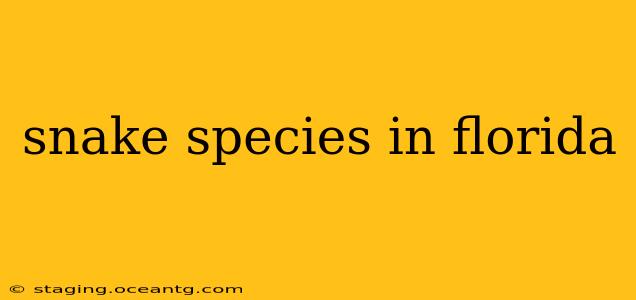Florida's diverse ecosystem supports a wide variety of snake species, ranging from harmless garter snakes to venomous cottonmouths. Understanding these snakes is crucial for both safety and appreciating the natural world. This guide explores the common snake species found in Florida, addressing frequently asked questions and providing crucial identification tips.
What are the most common snake species in Florida?
Florida boasts a rich herpetofauna, with numerous snake species inhabiting diverse habitats across the state. Some of the most commonly encountered snakes include:
-
Eastern Garter Snake (Thamnophis sirtalis): These slender, non-venomous snakes are easily identified by their distinctive stripes. They are often found near water sources and are relatively harmless to humans.
-
Black Racer (Coluber constrictor): A fast-moving, non-venomous snake known for its sleek, black coloration. They are often mistaken for venomous snakes, but pose no threat to people.
-
Corn Snake (Pantherophis guttatus): While native to other parts of the US, corn snakes are often found in Florida as escaped or released pets. These docile, non-venomous snakes are popular in the pet trade due to their beautiful patterns.
-
Brown Water Snake (Nerodia taxispilota): These semi-aquatic, non-venomous snakes are frequently found near water bodies. They are often mistaken for cottonmouths due to their dark coloration and similar body shape, but lack the characteristic heat-sensing pits.
-
Eastern Diamondback Rattlesnake (Crotalus adamanteus): This is Florida's largest venomous snake, easily identified by its diamond-shaped patterns and prominent rattle. Encountering one requires cautious observation and a safe distance.
-
Cottonmouth (Agkistrodon piscivorus): Another venomous species, cottonmouths are recognizable by their dark, almost black coloration and the characteristic way they open their mouths when threatened, revealing a bright white interior. They are commonly found near swamps and marshes.
What are some venomous snakes in Florida?
Florida is home to several venomous snakes, and understanding their identification is vital for safety. The most dangerous include:
-
Eastern Diamondback Rattlesnake: As mentioned above, this is the largest and potentially most dangerous venomous snake in Florida.
-
Cottonmouth: While not as large as the diamondback, cottonmouths are aggressive and their venom is potent.
-
Copperhead (Agkistrodon contortrix): Copperheads have a distinctive reddish-brown hourglass pattern on their back and are often found in wooded areas.
How can I identify venomous snakes in Florida?
Identifying venomous snakes accurately requires careful observation and knowledge. While general guidelines exist, relying solely on these for identification is not recommended. Always maintain a safe distance from any snake you cannot positively identify. Key features to look for in venomous snakes include:
-
Triangular head: Venomous snakes often have a broader, triangular-shaped head.
-
Heat-sensing pits: Pit vipers (cottonmouths and copperheads) have heat-sensing pits located between their eyes and nostrils.
-
Rattles: Rattlesnakes possess a rattle at the end of their tail.
-
Elliptical pupils: Venomous snakes generally have elliptical pupils, unlike the round pupils of many non-venomous species.
Important Note: These are general characteristics; exceptions exist. Never attempt to handle a snake you suspect is venomous.
What should I do if I see a snake in Florida?
Encountering a snake in Florida can be unnerving, but a calm and cautious response is key:
-
Identify the snake (if possible, from a safe distance): Observe the snake’s characteristics, but don't get too close.
-
Maintain a safe distance: Give the snake plenty of space and avoid sudden movements.
-
Do not attempt to handle the snake: Even non-venomous snakes can bite if they feel threatened.
-
Alert others if necessary: If you're in a public area, inform nearby individuals of the snake's presence.
-
Contact animal control or wildlife rescue: If you encounter a venomous snake or are unsure of its identity, contact your local authorities.
Are all snakes in Florida dangerous?
No, the vast majority of snakes in Florida are non-venomous and pose no threat to humans. Many play important roles in the ecosystem, controlling rodent populations and contributing to biodiversity. Respecting their space and understanding their behavior is key to coexisting peacefully.
This guide provides a starting point for understanding Florida's diverse snake population. Remember, always prioritize safety and respect the natural world. For definitive identification, consult with a herpetologist or other qualified expert. Learning to appreciate the diverse wildlife of Florida enriches the experience of living in this beautiful state.
